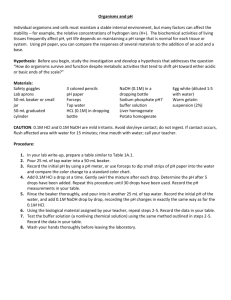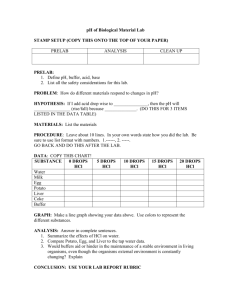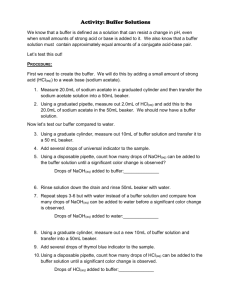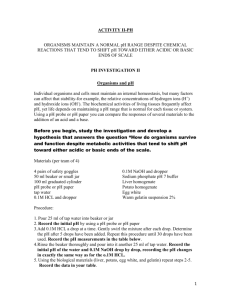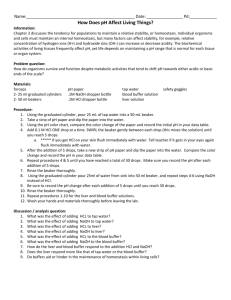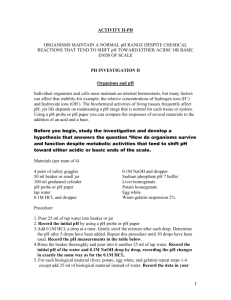Lab 19: Buffers
advertisement
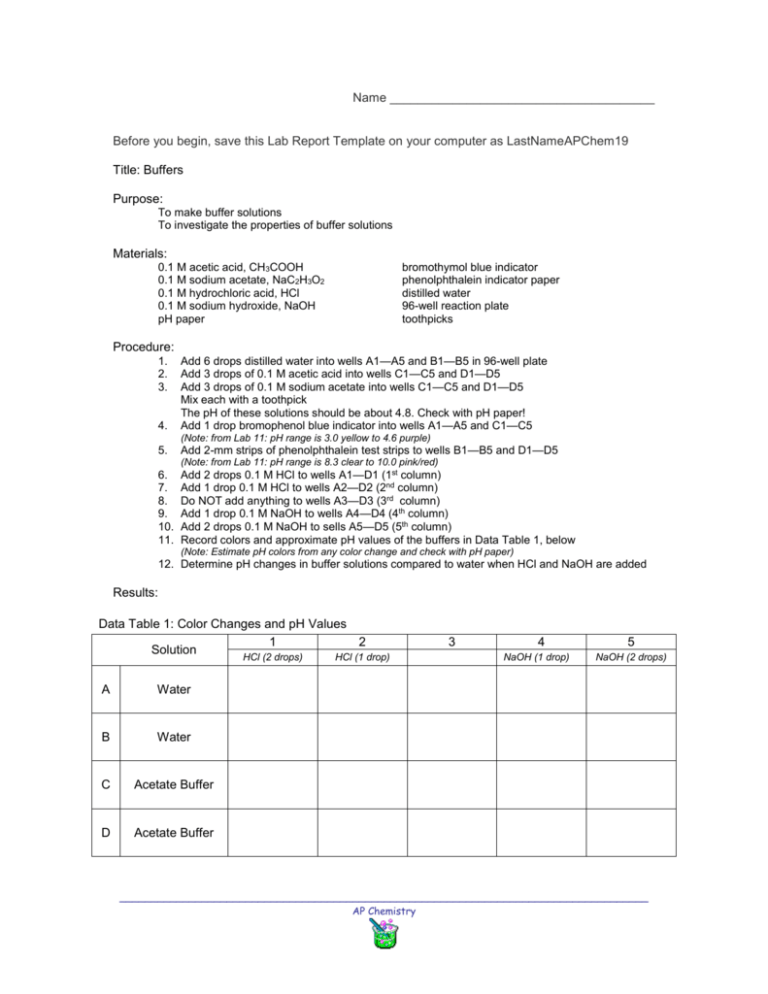
Name ______________________________________ Before you begin, save this Lab Report Template on your computer as LastNameAPChem19 Title: Buffers Purpose: To make buffer solutions To investigate the properties of buffer solutions Materials: 0.1 M acetic acid, CH3COOH 0.1 M sodium acetate, NaC2H3O2 0.1 M hydrochloric acid, HCl 0.1 M sodium hydroxide, NaOH pH paper bromothymol blue indicator phenolphthalein indicator paper distilled water 96-well reaction plate toothpicks Procedure: 1. 2. 3. 4. Add 6 drops distilled water into wells A1—A5 and B1—B5 in 96-well plate Add 3 drops of 0.1 M acetic acid into wells C1—C5 and D1—D5 Add 3 drops of 0.1 M sodium acetate into wells C1—C5 and D1—D5 Mix each with a toothpick The pH of these solutions should be about 4.8. Check with pH paper! Add 1 drop bromophenol blue indicator into wells A1—A5 and C1—C5 (Note: from Lab 11: pH range is 3.0 yellow to 4.6 purple) 5. Add 2-mm strips of phenolphthalein test strips to wells B1—B5 and D1—D5 (Note: from Lab 11: pH range is 8.3 clear to 10.0 pink/red) 6. 7. 8. 9. 10. 11. Add 2 drops 0.1 M HCl to wells A1—D1 (1st column) Add 1 drop 0.1 M HCl to wells A2—D2 (2nd column) Do NOT add anything to wells A3—D3 (3rd column) Add 1 drop 0.1 M NaOH to wells A4—D4 (4th column) Add 2 drops 0.1 M NaOH to sells A5—D5 (5th column) Record colors and approximate pH values of the buffers in Data Table 1, below (Note: Estimate pH colors from any color change and check with pH paper) 12. Determine pH changes in buffer solutions compared to water when HCl and NaOH are added Results: Data Table 1: Color Changes and pH Values 1 2 Solution HCl (2 drops) A Water B Water C Acetate Buffer D Acetate Buffer HCl (1 drop) 3 4 NaOH (1 drop) 5 NaOH (2 drops) ____________________________________________________________________________________ AP Chemistry Analysis Questions 1. What was the pH of distilled water? Was this what you expected? Explain any discrepancy you note. 2. How much did the pH of the distilled water change when you added the acids and bases? 3. 4. 5. 6. 7. To answer this question, you need to find the change in pH when HCl was added, not the pH! a. pH water – pH water + 1 drop HCl = ______ b. pH water – pH water + 2 drops HCl = ______ c. pH water – pH water + 1 drop NaOH = ______ d. pH water – pH water + 2 drops NaOH = ______ How much did the pH of the acetate buffers change when you added the acids and bases? a. pH acetate buffer– pH acetate buffer + 1 drop HCl = ______ b. pH acetate buffer – pH acetate buffer + 2 drops HCl = ______ c. pH acetate buffer – pH acetate buffer + 1 drop NaOH = ______ d. pH acetate buffer r – pH acetate buffer + 2 drops NaOH = ______ Explain what a buffer is and how it functions. Explain how you can determine whether or not a solution is a buffer. Explain what you might do to determine the buffer capacity of a buffer solution Why is aspirin sometimes buffered? Conclusion: None required Reflection: Personal commentary about what you learned from the lab activity ____________________________________________________________________________________ AP Chemistry


